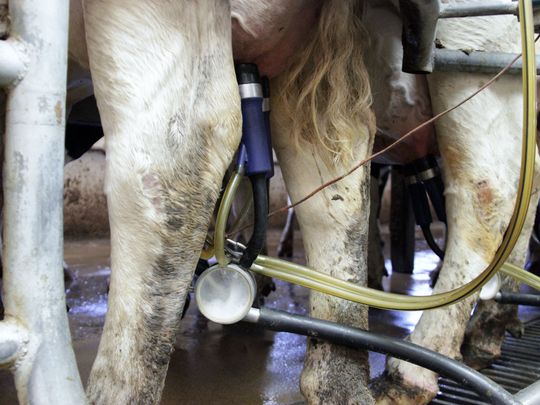
In an interview with GreenBiz, an organization that advances opportunities at the intersection of business, technology and sustainability, Vilsack put dairy’s progress into a personal context.
“In my lifetime, we’ve seen about a five-fold increase in productivity of a cow in terms of milk produced,” Vilsack said, citing information from The Innovation Center for U.S. Dairy. “So more milk is being produced, with less water, less land and less inputs than when I was born.”
Bob Langert, editor at large at GreenBiz and former vice president of sustainability at McDonalds, interviewed Vilsack, who made these three points about sustainability among other topics addressed in the Q&A:
1. Dairy needs more marketing of its positive sustainability story.
Vilsack cited two programs that demonstrate the dairy industry’s commitment to sustainability.
“Dairy farmers, through their checkoff program, have created the Innovation Center for U.S. Dairy. It consists of the producers and processors of a substantial amount of the milk that’s generated in this country. And in the Innovation Center there is a deep commitment to sustainable production,” he said.
“In fact, there is a specific commitment that processors and producers are making that acknowledges their willingness to follow a rigorous set of standards, including operating under a program called Farmers Assuring Responsible Management, or FARM, which provides standards, information and guidance on animal welfare, environmental stewardship and more.
2. Dairy must address misleading negative claims reaching consumers.
“We’re seeing a lot of issues with reference to negative advertising or negative marketing where people are making negative claims (such as) ‘my product doesn’t contain X; it doesn’t contain GMOs; it doesn’t contain pesticides; it doesn’t contain hormones,'” Vilsack said.
“And, often times, there is no safety issue associated with whatever they’re claiming they don’t have in their product,” he said. “With these claims, there is a suggestion or implication that the other products are not safe or not worthy of being consumed.
“Certainly, in the dairy industry we see a lot of this—”no antibiotics,” for example, on many milk cartons. The reality is that no commercially sold milk has antibiotics in it. So, if you put this on the label and your carton is next to a carton that doesn’t contain that label, are you suggesting that bottle that doesn’t contain the label is unsafe?
“I think that what is needed is a continued platform for conversation and discussion, so that a consensus can be reached, so it’s easier for farmers to know what to do, easier for farmers to access the resources to be able to do it, and then encouraging more responsible marketing on the part of the food and agriculture industry so the consumers are not misled,” Vilsack said.
3. Agriculture in general, not just dairy, needs to do a better job explaining how advancements in technology enhance sustainability.
“I’ll use the example of corn, which I’m most familiar with,” said Vilsack, a former U.S. Agriculture Secretary and Iowa governor.
“When I started practicing law in a small town in southeast Iowa, representing farm families, I was aware of the fact that on the best land in the world we were planting about 15,000 to 17,000 corn seeds per acre. Today, that same land—in fact, that same farmer—is probably utilizing 30,000 to 40,000 seeds on that same acre.
“How are they able to do that? Well, they’re able to do it through technology, through seed technology, through GMO technology. They’re able to do it with less pesticides and less chemicals per ear of corn, just simply because of this technology. So, naturally, in a system that rewards productivity, that rewards efficiency, a farmer takes full advantage of that opportunity.
“The problem is that when these new technologies are introduced, the companies that are introducing them only message to the people that are directly affected by the technology.
“In other words, the seed companies basically only talked to the farmers and producers about how great these GMO seeds are going be. They didn’t talk to the consumer about this. They didn’t educate the consumer in advance,” Vilsack said.
Vilsack said that with better education, consumers will see the benefit of technology in food production.
Mark O’Keefe is vice president of editorial services at the U.S. Dairy Export Council.























